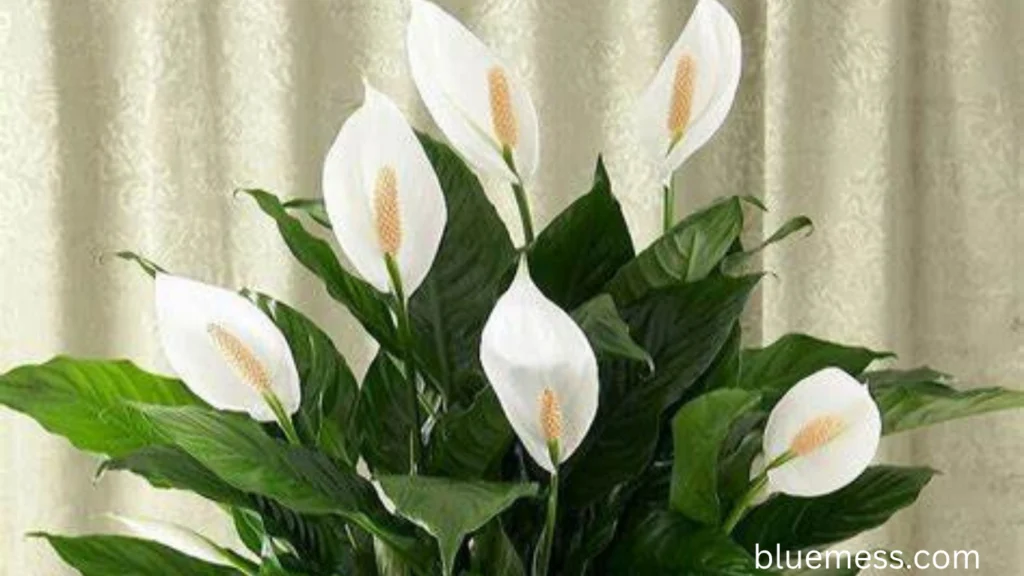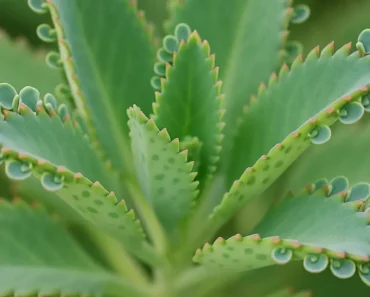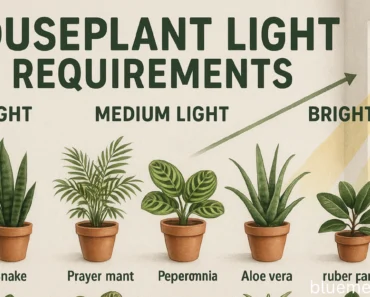
Key Takeaways:
- Peace lilies thrive in low to moderate light and prefer to be slightly underwatered
- They’re excellent air purifiers but toxic to pets and children
- Consistent humidity and temperatures between 65-80°F keep them happiest
- Getting them to bloom requires patience and consistent care conditions
- Yellow leaves usually signal watering issues, while brown tips indicate humidity problems
Picture this: you enter a dim corner and find a lush peace lily with white flowers, adding instant elegance. That’s the magic—beautiful yet forgiving.
Peace lilies can seem dramatic, drooping their leaves when thirsty like a plant protest. But after years of growing them, I’ve learned that understanding their needs makes them incredibly rewarding houseplants.
Table of Contents
What Makes Peace Lilies So Special
Peace lilies aren’t actually lilies at all (surprise!). They’re members of the Araceae family, originally from the tropical rainforests of Central and South America. The botanical name Spathiphyllum literally means “spathe leaf.” A spathe, in this case, is a large, leaf-like bract that looks like a flower but actually surrounds the plant’s real flower, making those gorgeous white “flowers” actually modified leaves called spathes.
These plants evolved on the rainforest floor, thriving on filtered light and high humidity—explaining their success in shady homes.
A healthy peace lily can live 20+ years and bloom twice a year, offering enduring, air-purifying companionship.
Note: Peace lilies are toxic to pets and kids due to calcium oxalate crystals. Keep them out of reach if you have curious animals or children.
Understanding Your Peace Lily’s Basic Needs
Peace lily care is about consistency, with no big changes. Here’s what they need:
Light: Bright, indirect light from a north or east window is ideal. Too much direct sun can scorch leaves.
Temperature: Peace lilies like 65–80°F and hate cold drafts. Keep away from vents, drafty windows, and doors.
Humidity: This is where peace lilies show their tropical roots. They love humidity, ideally around 40-60%. If your home is dry (especially in winter), try misting the leaves weekly with distilled water, or place the pot on a humidity tray—a shallow tray filled with pebbles and water below the pot, which increases moisture in the air around the plant.
Mastering the Watering Game
Here’s where peace lilies get their dramatic reputation – they’re very clear about their watering preferences. The golden rule? They’d rather be slightly thirsty than drowning.
When thirsty, peace lilies droop slightly—just water thoroughly when you see this sign.
Water until it drains below, then let the pot drain fully. Standing water quickly causes root rot.
In winter, water less often as growth slows. I water every 7–10 days in summer and every 2 weeks in winter, but let your plant guide you.
Pro tip: Water from the bottom, not over the leaves, to prevent black spots.
Creating the Perfect Growing Environment
Soil That Makes Them Happy
Peace lilies are used to rich, organic soil that drains well but holds some moisture – think of the forest floor where leaves decompose into perfect plant food. I use a high-quality potting mix and add some perlite (a lightweight, porous material that improves soil drainage) for extra drainage. The soil should feel like a wrung-out sponge: moist but not soggy.
Feeding Your Plant
Feed weekly during spring and summer with diluted balanced fertilizer (20-20-20). Avoid overfertilizing to prevent poor blooming.
Skip fertilizer in winter; feeding during dormancy can stress the plant.
Repotting Without the Drama
Peace lilies actually prefer to be slightly root-bound – that means the plant’s roots fill most of the pot space, often circling around inside the container. Being a little crowded can encourage blooming. I only repot when I see roots coming out of the drainage holes or popping up from the soil surface. This usually happens every 2-3 years.
When repotting, use a pot about 2 inches wider and fresh soil. Be gentle with roots; spring is best.
The Varieties You’ll Fall in Love With
I love the variety of peace lilies: from small desk plants to dramatic floor specimens, there’s one for every space.
‘Power Petite’ is perfect for small spaces – it only grows to about 15 inches and is ideal for desks or shelves.
‘Wallisii’ is the classic variety, known for deep veins and reliable blooms.
‘Sensation’ can reach 6 feet with huge 20-inch leaves—a dramatic presence in any room.
‘Mauna Loa Supreme’ is common in stores—reliable, grows 3–4 feet, and blooms well with care.
Getting Those Coveted Blooms
Getting peace lilies to bloom indoors can be tricky, since our homes aren’t rainforests.
Blooming requires steady care: consistent light, regular watering, humidity, and feeding. Routine works best.
Most peace lilies bloom in spring, around April, and may surprise you with a second flush in fall. The flowers start as green spathes that gradually turn white, lasting for several weeks before slowly fading to green again.
If it won’t bloom, move it to brighter light (no direct sun), increase humidity, and fertilize in growing season. Sometimes letting it get a bit root-bound can help.
Troubleshooting Common Issues
Even with the best care, peace lilies will occasionally have off days. Here’s how to play plant detective:
Yellow Leaves
Yellow leaves signal over- or underwatering. Check the soil: soggy means too much, bone dry means too little. Poor water quality also causes yellowing.
Brown Leaf Tips
Brown tips mean dry air (increase humidity), salt buildup, or too much fertilizer. Flush with distilled water and ease up on feeding.
Curling or Pale Leaves
Too much light causes curling or pale leaves. Move to filtered light—damaged leaves won’t recover but new growth will be healthy.
No Blooms
No blooms? Young plants need 2–3 years to mature. For stubborn plants, check light, fertilizer, and care consistency.
Propagating Your Peace Lily
Peace lilies are generous: repotting often reveals natural divisions. Each cluster can be separated and replanted.
Separate clumps, ensuring each has roots and leaves. Replant in fresh soil and keep warm and bright—a new plant will grow fast!
The Bottom Line on Peace Lily Care
Peace lilies are one of the most beloved houseplants for good reason. They’re forgiving for beginners and interesting for experienced plant parents. Their dramatic watering cues are just their way of communicating with you.
Consistency is key: bright, indirect light, water when needed, humidity, and feeding during growing season. In return, enjoy lush beauty and blooms.
Each plant is different. Watch your peace lily and adjust care as needed.
Ready to try peace lilies? Buy a healthy plant, follow these care tips, and be patient—soon you’ll see why they’re so popular.
Questions or challenges? Share your peace lily experiences—there’s always more to learn!
Author
George Wine is a seasoned gardening expert with over 20 years of experience in the field of horticulture. His passion for plants and nature has driven his career, where he has honed his skills in various aspects of gardening, from landscape design to plant care. George holds a Master of Science in Horticulture from the University of California, Davis (UC Davis), a prestigious institution known for its research and advancements in plant science.
Throughout his career, George has worked with a diverse range of clients, offering tailored solutions to enhance outdoor spaces and create thriving gardens. His knowledge and expertise allow him to provide invaluable advice, ensuring that both novice and experienced gardeners achieve their gardening goals. Whether you’re looking for tips on sustainable gardening practices, innovative design ideas, or advice on specific plant species, George is here to help you cultivate the garden of your dreams.






